
How innovative companies are turning Snowflake into a marketing growth engine with Flywheel Software
We’ve researched dozens of the world’s most successful companies in search of the keys to sustained growth, and we found a single, consistent pattern: customer segmentation and experimentation.
The good news is that Snowflake and Flywheel have recently made this pattern of growth accessible to mid-market and enterprise companies alike, many of whom may lack the data science resources or bandwidth that was previously needed.
The challenge
- Growth goals vary widely, but the consistent thread among them is that they are benchmarked on prior performance and defined in terms of growth rates. This means companies need to find repeatable ways to grow.
- Marketers and business teams are locked out of customer data and insights because they lack technical skills to self-serve for marketing analytics, or are limited to a partial view of the customer in their marketing automation systems.
- Experimentation is hard to execute because it requires dedicated data science, marketing analytics, and statistical experts, but it is critical to finding repeatable success.
While some share of those challenges stem from business priorities, we found the majority are solved with a proper technology foundation that removes data friction and makes growth repeatable and sustainable.
Pattern of success
So how do the most successful companies in the world sustain growth rates that are above their peers? What’s the recipe for success? The answer lies in three methods of applying data-driven marketing in a scalable way:
1. An operational single source of truth for customer data
These companies centralize their marketing intelligence by investing in the Snowflake Data Cloud, capturing the key data points that inform customer outcomes for their marketing analytics team. The key difference is that they also drive campaigns from a single source of truth. Most importantly, their marketing and business teams have an accessible, self-serve way to launch campaigns from highly valuable customer insights (a seamless bridge to marketing analytics).
2. Customer-centric (not channel-centric) campaign execution and measurement
These successful companies apply the same scientific method to marketing that brought us penicillin: variation and experimentation. The key is that they measure this experimentally at the customer and audience level across sales and marketing channels, rather than simply the campaign or channel level. This allows the marketing analytics team to answer questions such as, “What is the impact on customer lifetime value of a marketing or sales action?” rather than just the next conversion event. This represents a whole new paradigm for many marketing analytics teams.
3. Ideation and experimental velocity
When marketing teams have the ability to immediately act on results, they’re able to shrink the gap between idea and cross-channel testing to change their customer experience—thus achieving a differentiated speed of experimentation across marketing and sales channels.
In short, these marketing and sales teams test and learn faster because they can operate with autonomy. They are not dependent on technical resources and analytics teams to design, implement, and measure their campaigns because they have the right technology to support their team’s efforts. As a result, they launch more data-driven campaigns and close the loop on customer outcomes.
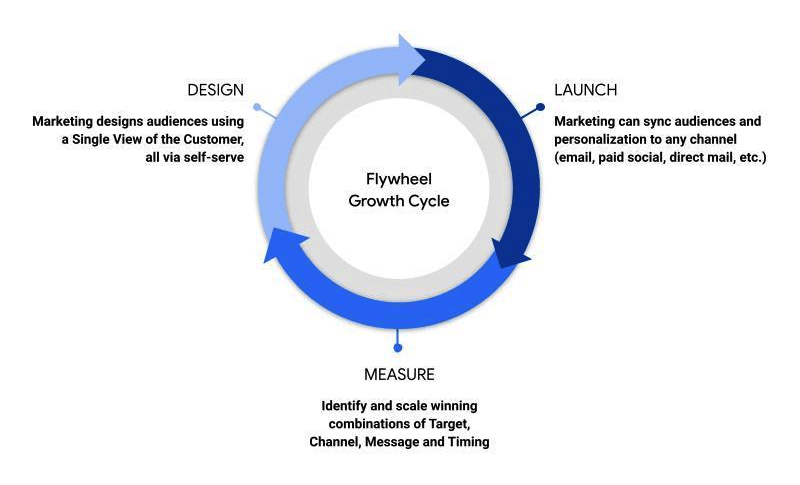
Experimental velocity leads to compounding growth
Compounding growth is one of the most impressive forces in nature and business (just ask Warren Buffett). The most successful companies think differently about marketing, sales, and product-led growth; rather than look at aggregate volumes, they think about experimental velocity to compound their growth at each stage of the customer lifecycle.
The question then becomes: What is your business’s unit of compounding? Are improvements to growth compounding annually, quarterly, monthly, or even faster?
So, how do you drive experimental velocity at your organization?
The 4 ingredients to experimental velocity
1. Understand the Customer 360
The first ingredient to driving experimental velocity is to fully understand your customer’s context and journey. Leading companies bring together everything they know about their customers to derive actionable insights that inform targeting and messaging. For these companies, Snowflake acts as the data exchange between different lines of business, departments, and product areas because of how simple it is to land and model a single view of the customer (sometimes also called a “Customer 360”). By ingesting all customer interaction data (e.g., website interactions, mobile app downloads, point-of-sale (POS) purchase data, etc.) into Snowflake, your team is ensured a more holistic customer view.
Identity resolution is the process of thoughtfully consolidating customer identifiers from various sources into a single profile. A detailed explanation is available here, and Flywheel can help you get there faster by working directly in Snowflake.
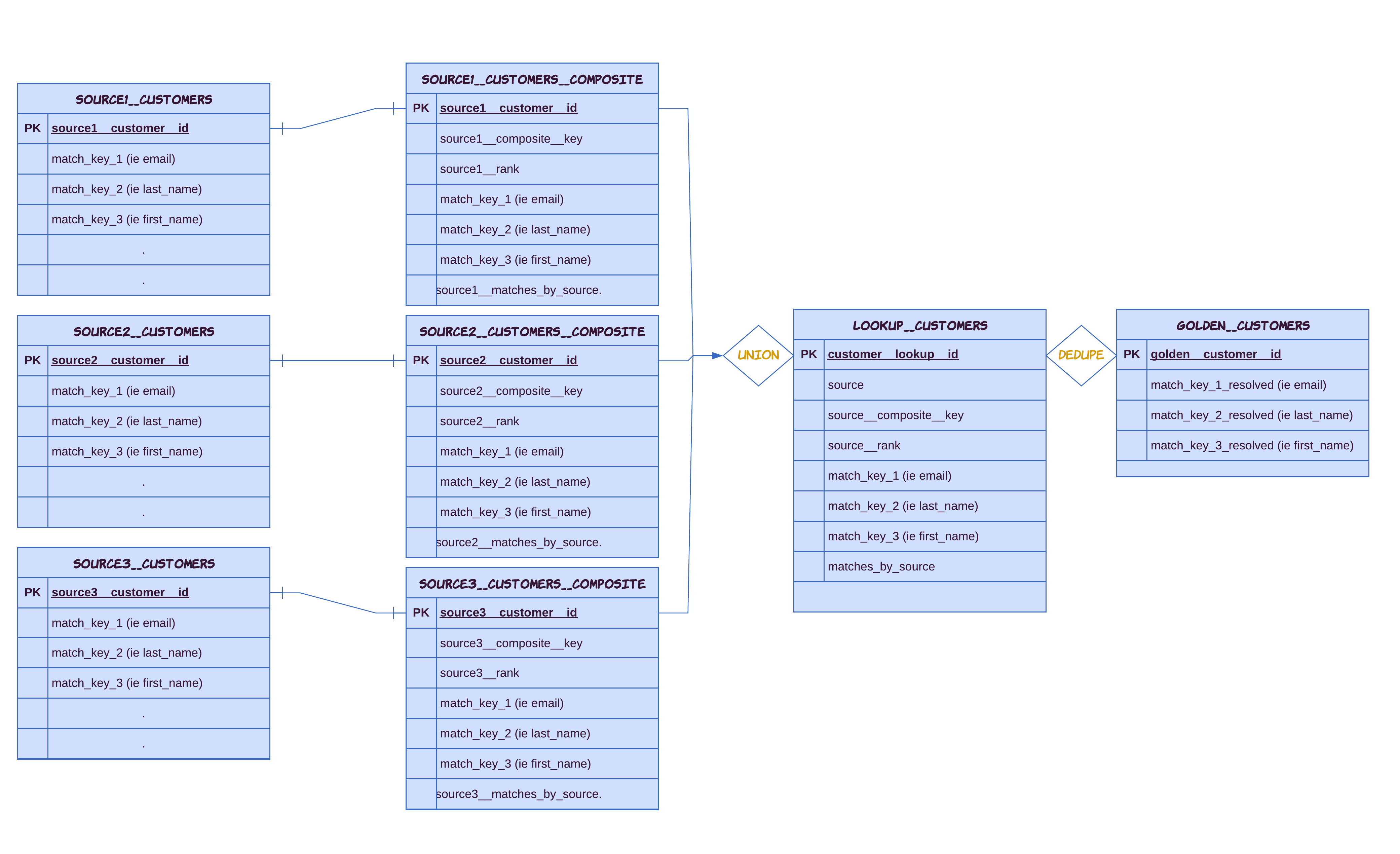 Tables illustrating the composite key identity resolution in Snowflake
Tables illustrating the composite key identity resolution in Snowflake
2. Build smarter segmentation model variations to test
An essential step missed by most companies is the creation of a mutually exclusive and comprehensively exhaustive (MECE) segmentation model (one example, RFM, is visually represented in the Flywheel Audience Platform below). The key is that your team builds segmentation using the most important attributes that distinguish customers from one another. For example, a quick service restaurant will create segments based on dietary preferences utilizing its POS data; a segment could be customers who purchase a gluten-free sandwich at least 9 times in the last 10 purchases, and with a purchase frequency of at least once per week.
When constructed thoughtfully, these segmentation models empower marketers to take smarter bets on which combination of (i) target, (ii) message, (iii) channel, and (iv) timing will be most effective. Designing audiences to test then becomes as easy as color-by-number rather than painting on a blank canvas. The result is highly personalized campaigns and an assurance that all customers receive the right frequency of communication.

3. Cross-channel activation: Scale consistent customer experiences across channels
Most companies make the mistake of channel-centric marketing rather than audience-centric marketing because they tend to hire one person to run their email channel and another to run their paid social campaigns. The problems with this include disjointed customer experiences, messaging conflicts, and a lack of clear incrementality given other channels’ activity.
By leveragingaudience-centric marketing, you activate audiences to all channels, which ensures your customer is seeing a consistent cross-platform message. If we continue the quick service restaurant example, let’s say its activating the gluten-free customer audience on TikTok and Facebook to show them ads of its new gluten-free flatbread.These cross-channel ads on TikTok and Facebook will be shown to the audience in the weeks leading up to the launch of the new gluten-free flatbread.
“Flywheel activates the Snowflake Data Cloud for our marketing team, which means the Lifecycle Segmentation models developed by our Marketing Analytics team are available across our marketing channels.”
Judy Nam, VP of SMB Marketing at Indeed
4. Measurement: Find repeatable winners via experimentation and scale them
Traditional marketing attribution based on cookies and opens is becoming less and less effective, leaving marketers and marketing analytics teams guessing about what’s working. By using Flywheel’s Automated Experimentation, marketers are finally able to measure the impact of their marketing campaigns to any metric in the Snowflake Data Cloud. In our quick service restaurant example, the personalized messaging to its gluten-free customer audience drove a revenue uplift of 44% and doubled the number of mobile app downloads. By knowing the impact, the restaurant could then continue to iterate on this initial success, expanding to more audience segments.
Referencing back to our MECE segmentation model, the mutual exclusivity means that the incremental impact over time for each audience can be summed up to create an overall impact of the marketing segmentation strategy (below).

How to get started
Consolidate customer data in Snowflake
In order to consolidate customer data from multiple sources into Snowflake, many companies turn to tools like Fivetran. Other companies don’t have the internal technical resources. In those cases, Flywheel works closely with its partners and can help build a Single View of the Customer in 4 to 8 weeks, a much shorter duration than is typically available. Companies using Flywheel have found the Snowflake Data Cloud to be the best place to build the Single View of the Customer because: (i) its ecosystem of data integrations are comprehensive, (ii) data access and governance controls are strong, and (iii) it can scale virtually infinitely with concurrent requests. It also supports the security needs of highly regulated industries such as financial services and healthcare.
“Flywheel’s dedicated customer team handled all the heavy lifting to ensure a quick time to value.”
Braden Moore, VP Data & Analytics, Philadelphia 76ers
Leverage Flywheel Software (a Snowflake Connected App) to Design, Launch, and Measure Audiences
Visual audience builder for marketing and sales teams
Flywheel offers a visual audience builder for marketing and sales teams that accelerates the design – launch – measure cycle of innovation by putting it all in marketers’ hands. The instant feedback this provides means marketers launch smarter tests, and more of them, without data bottlenecks, SQL skills, or data team members’ support.
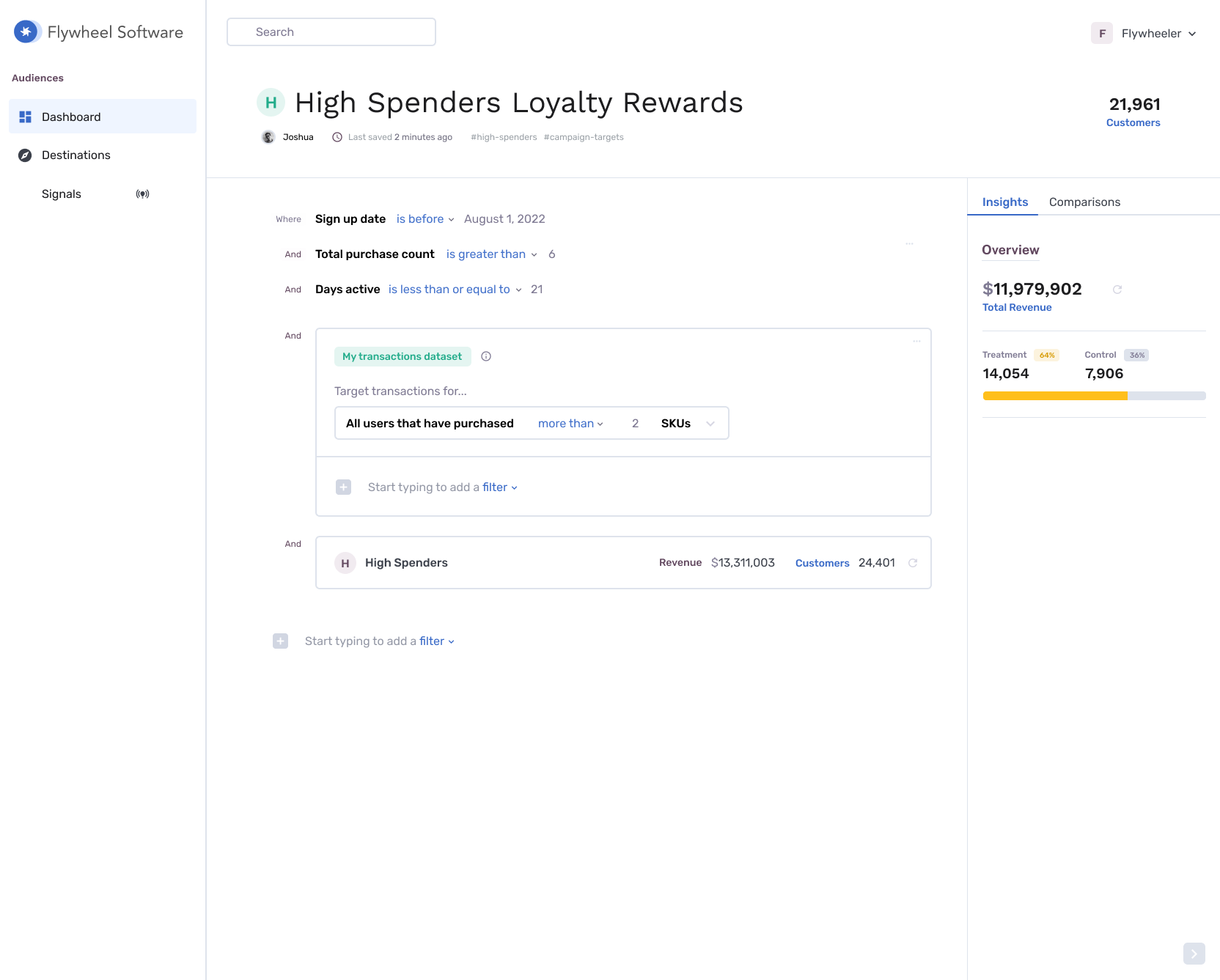
“Thanks to Flywheel’s no-code platform, our marketing team can self-serve to build audiences directly on Snowflake for the first time. This has had a big impact on our team’s velocity—we’ve been able to 8x the number of campaign launches per quarter.”
Judy Nam, VP of SMB Marketing at Indeed
Connected App Architecture
Flywheel’s Connected App architecture means it connects directly to your existing Snowflake tables and views. There is no need to “sync” any data to Flywheel; you simply connect the tables your analytics team already uses for reporting. This architecture is the key insight that differentiates Flywheel from other platforms that serve marketers. Here’s a quick summary of the benefits to using a Snowflake Connected App:
- Fast time to value for marketing-critical use cases
- Allows users to leverage your single source of truth
- Provides scalability in lockstep with Snowflake
- Leverages Snowflake’s native security features
For highly regulated industries such as financial services and healthcare, you don’t have to replicate sensitive targeting data outside of Snowflake.
“In an increasingly security-conscious and regulated world, it no longer makes sense to ship your data to a SaaS application and create another data silo. Snowflake is empowering next-gen providers like Flywheel to build on top of their customers’ Data Cloud. These Connected Apps are seeing adoption across all major industries—it’s a true win/win for both the customers and the providers.”
Luke Ambrosetti, Partner Solution Engineer at Snowflake
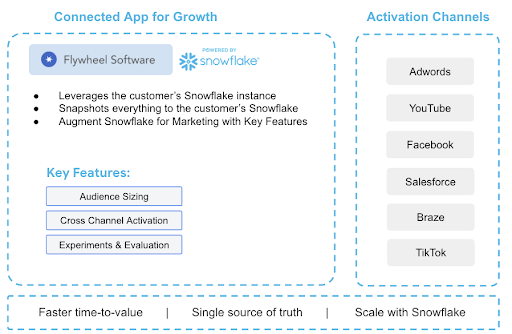
Launch cross-channel audiences with Flywheel
With the power of Snowflake’s Data Cloud, teams can now ingest customer touchpoints across email, push, SMS, and phone calls from platforms like Marketo, Braze, and Salesforce. With the addition of Flywheel, you can then easily leverage previous interactions to create a cross-channel experience for customers. For example, imagine targeting all churned customers that have not clicked an email in the past 90 days with an Instagram advertisement. Since you are unable to reach them via email, you can now target them with a paid ad on your platform of choice—this allows you to reach customers and prospects in the channels with which they most engage.
Flywheel automates experiments to make measurement easy
Once your team is driving more variation and faster experimentation, how can you know what’s working? This is a crucial component of the Flywheel growth cycle that drives the outsized performance for innovative companies. Flywheel embeds intelligence (e.g., segmentation models) and measurement (e.g., experimental automation) to the activation layer because it is the most important piece to achieving compounded growth.
Teams using Flywheel have launched on average over 120 audiences within their first 3 months, identifying 14 key segments and generating over $800,000 in revenue lift.
“Flywheel Software has allowed us to take a leap forward in our ability to leverage customer data. Thanks to Flywheel, our marketing and sales teams can build complex audiences, launch campaigns directly in a multitude of destinations, and measure impact within minutes. Flywheel is truly an accelerator for our business, empowering marketers to drive growth while freeing up our data team to focus on advanced analytics.” —Braden Moore, VP Data & Analytics at the Philadelphia 76ers
Marketers are launching successful cross-sell, upsell, and winback campaigns with Flywheel—supercharged by customer data
Today, marketing teams use Flywheel’s visual audience builder to create audiences from any data point in the Snowflake Data Cloud, often from insights discovered by their marketing analytics team. As an audience is being built, instant insights about that audience are surfaced so marketers can ensure they are targeting the right customers. Next, marketers can sync that audience with one click to their selected sales and marketing channels. Flywheel supports a huge variety of sales and marketing channels from TikTok to Salesforce, so marketing teams can reach customers where they engage the most.
Flywheel’s automated experimentation is built in, ensuring testing and measurement is seamless and standardized. Marketing teams that use Flywheel can measure performance on any metric in Snowflake, from revenue lift to mobile app downloads and loan originations. It’s like having an entire team of data scientists dedicated to marketing!
Upsell in the technology industry
Once your company has acquired a customer and turned them into a fan of your brand, the next logical step is to upsell. A tech company with a product-led growth model is especially focused on upselling free users to paid products. One successful upsell campaign approach has been to target an audience of free users with high product engagement, and who were acquired less than 30 days earlier, with push notifications and sales outreach to purchase a paid subscription and receive 10% off that first month.
Predictive upsell in partnership with sales
Give your sales team better marketing qualified leads (MQLs) with more context through CRM automation across channels like Salesforce and Microsoft Dynamics. The best examples of these have been powered by simple predictive models that forecast customer lifetime value, or a propensity model to help target sales efforts to the highest scoring set of leads. The result is that sales and marketing operate in lockstep for the first time, with unified messaging across channels and warmer, more timely leads for your sales reps.
Seasonal winback in retail
All industries have churned customers that, when targeted thoughtfully, can drive revenue at the right times. One of the biggest growth levers in retail is winning back last year’s holiday shoppers. An example of a successful campaign approach is targeting an audience of customers who only purchased on Black Friday with an email and SMS campaign starting November 1 promoting an exclusive 20% discount. This allows marketers to leverage and automate the seasonality within specific customer segments.
Cross-sell in financial services
Banks and financial services companies have a goal of expanding their share of wallet, and in order to do so they cross-sell existing clients to new financial products. A great example of a successful campaign, as illustrated below, has been to target existing checking account clients that have a balance greater than $3,000 with an email promotion and paid social advertisements to deposit $500 in a new savings account and receive a $100 bonus. The Flywheel user experience for building this audience and syncing it to marketing platforms can be seen below.

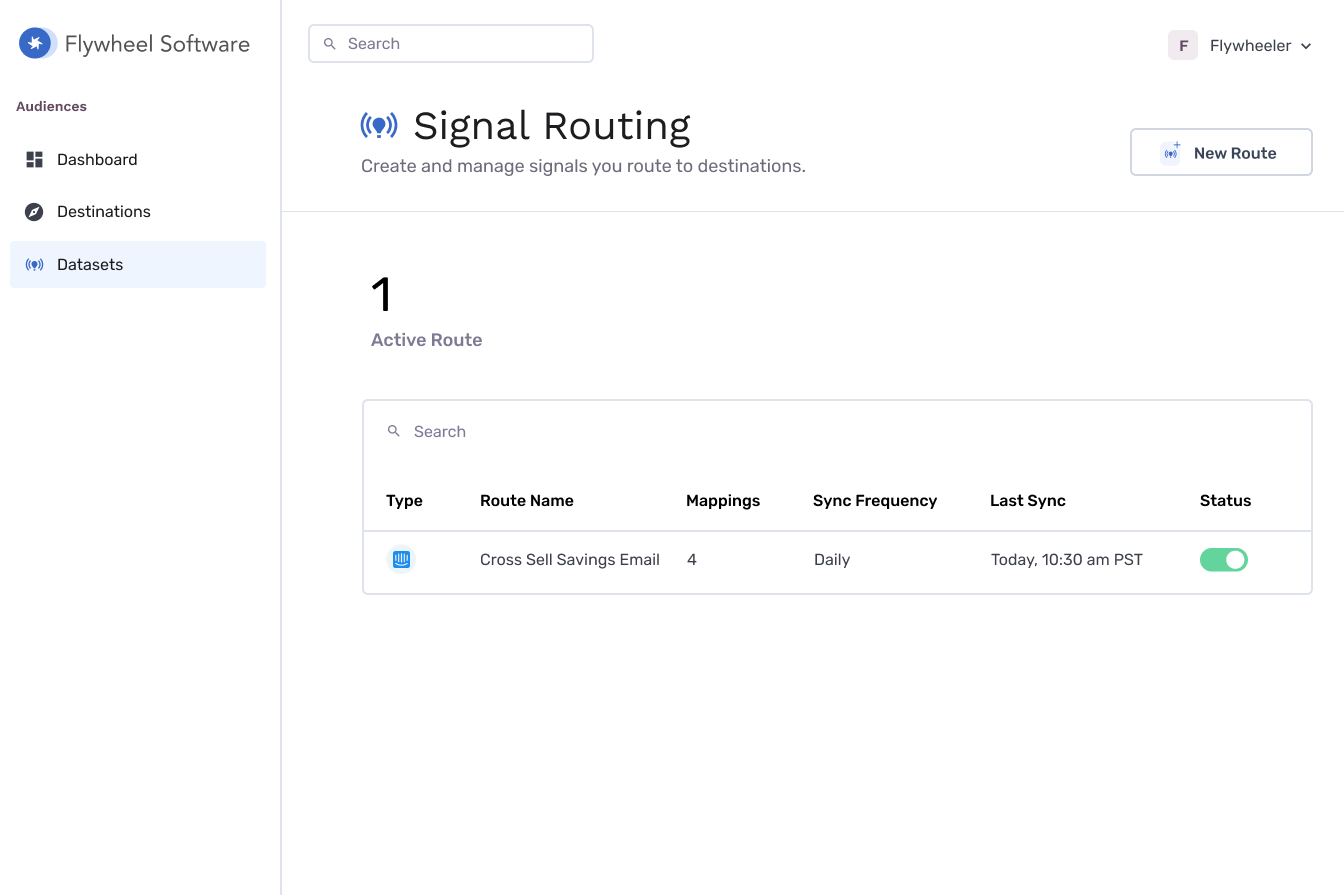
Data-driven growth is now accessible to everyone
We believe that Snowflake is at the beginning of a foundational change in the way marketing, sales, and product-led growth are done. No longer are the impressive personalized marketing programs at companies like Indeed and NASCAR locked behind massive data science teams consisting of hundreds of people.
Snowflake has partnered with Flywheel Software to make the same data-driven, personalized growth engine possible for every other team. To learn more about how to set up and execute a data-driven growth engine, check out this Executive Summary. To speak to a Flywheel expert about how Snowflake and Flywheel can empower you to drive experimental velocity at your organization, click here.



